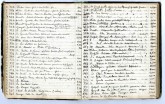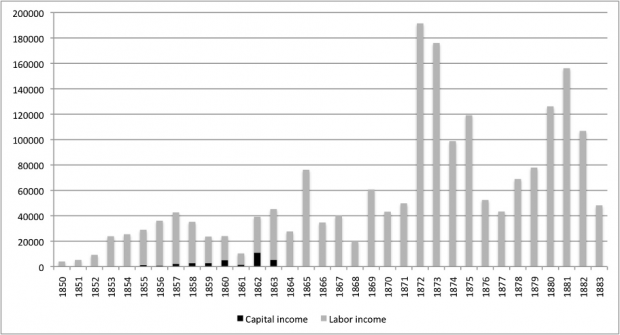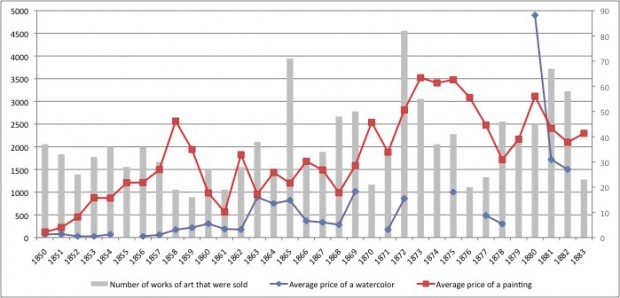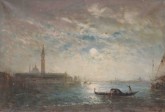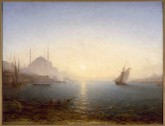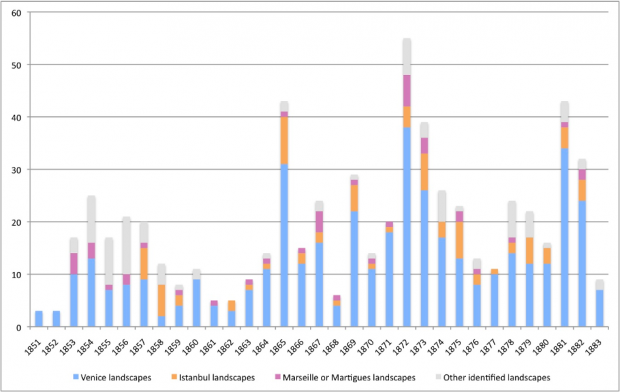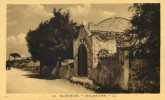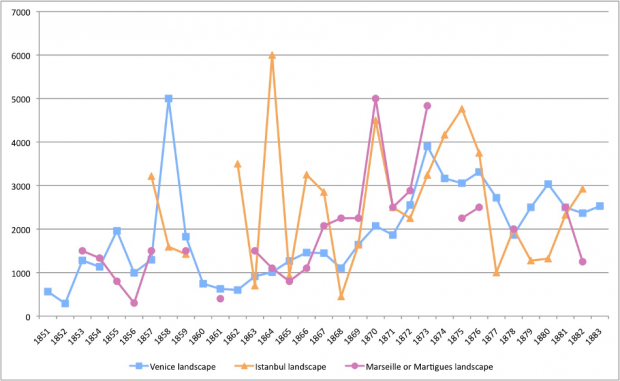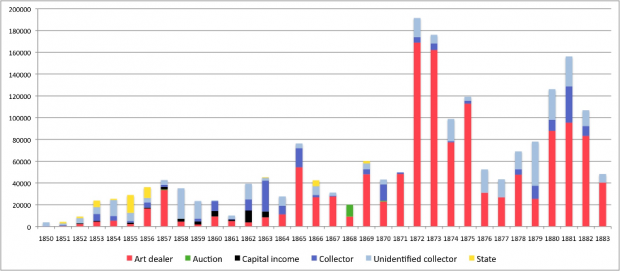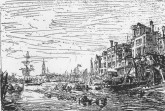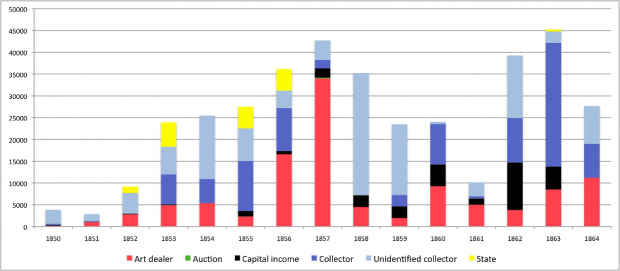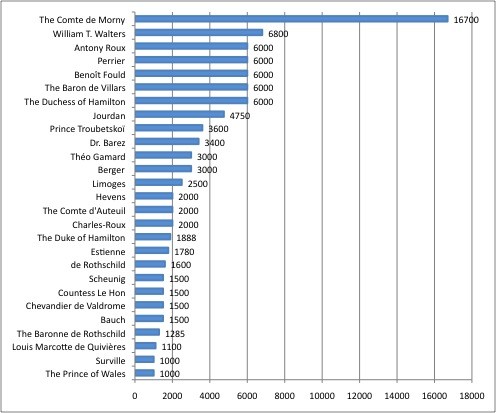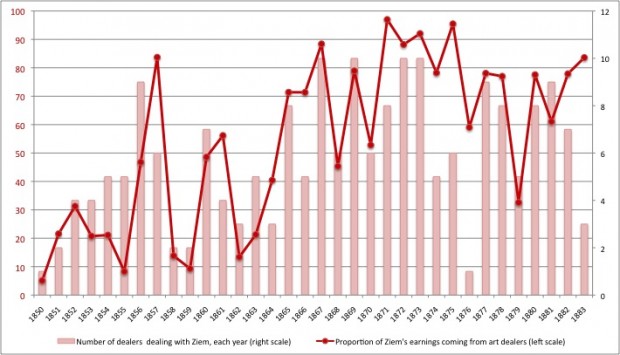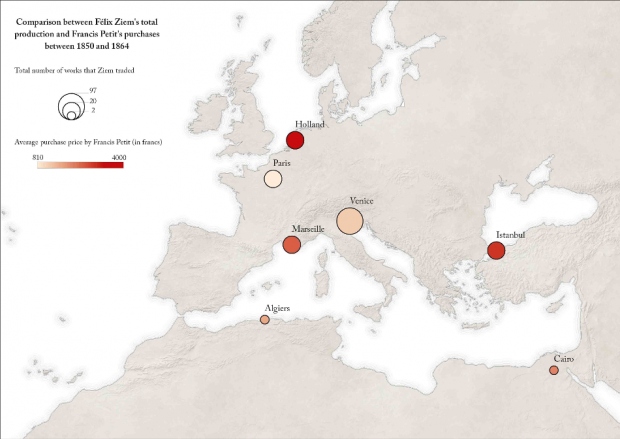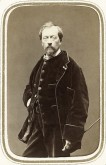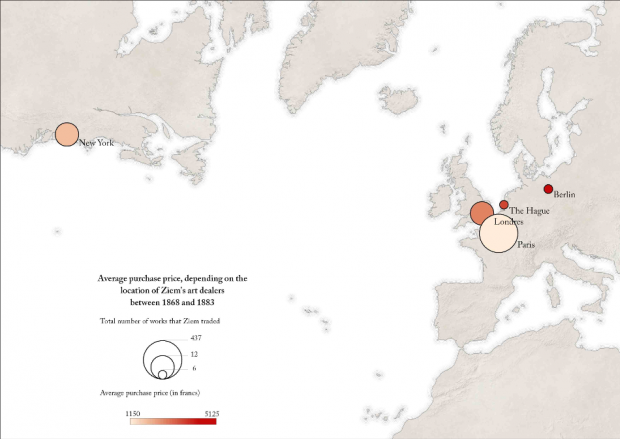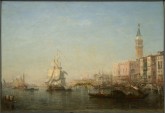The browser will either open the file, download it, or display a dialog.
Félix Ziem (1821–1911) was one of the wealthiest artists in nineteenth-century France. Recognized as the “painter of Venice,” he made his reputation in the 1850s by displaying his landscapes at the Paris Salon. In 1910, thanks to a bequest of Alfred Chauchard that included a number of his paintings, he became the first artist whose works entered the Louvre Museum during his lifetime. To what did the artist owe his fame and fortune? The key to understanding his reputation and, especially, his monetary success, is his account book, which he kept meticulously for more than thirty years, from 1850 to 1883.[1] The aim of this article is to open this “black box” in order to understand both his economic success and the social networks at its core.
For an art historian, artists’ account books are all the more valuable, as they are rare.[2] Unlike the more common dealers’ ledgers, which concern both first-hand and second-hand sales, Ziem’s account book only provides information about the works he sold directly to his customers, or, what we might call the primary art market. To properly understand Ziem’s account book, I have used a methodology that takes into consideration its quantitative and serial aspects. The analysis is thus based on econometrics, social network analysis, and mapping.
What Can Be Learned from Félix Ziem’s Account Book
Owned by the Musée Ziem in Martigues, France, the account book is an 86-page notebook recording the artist’s sales transactions from 1849 to 1883 (fig. 1). In leafing through the notebook, it quickly becomes clear that Ziem changed the notation as time went by. In 1849, he began his accounting with a two-column assets vs. liabilities format. While Ziem always recorded the name of the person he was dealing with and the amount of the transaction, the description of the artworks and the number of works sold were usually missing. One year later, his bookkeeping became more precise: Ziem recorded the number of paintings and watercolors that he sold. This is why our analysis of Ziem’s account book starts from 1850. From 1854, the descriptions of the paintings or watercolors he sold became more precise, now including terms such as “Venice sunset,” “small Montmartre,” “big Venice,” and “Venice party.” The year 1863 witnessed a shift in the accounting: Ziem stopped recording the capital income from the annuities, bonds, and shares he owned. At the same time, he began giving more specific details of the works of art he sold, registering information about a landscape’s colors, light, weather, and time of day, and by adding personal comments. He also started giving a chronological identification number to some transactions. Thus, for example, one can read that in 1865 Ziem, sold to the art dealer Emmanuel Weyll—written “Weylle” in the account book—a “Sunrise Bragosi, bright (sun), quite good, fine,” which is recorded with the number 123, on the 35th unnumbered page (fig. 2). The account book thus gives the year—sometimes the month—of the sale, the name of the purchaser, the selling price of the work, and a very short description of the work.
To identify the persons with whom Ziem was dealing, I used the address list for buyers in 1860, situated in the back of the account book, various other primary sources; the literature on Ziem; and books and articles on the art market.[3] In the end, 60 percent of the buyers remained unknown. It was even harder to identify the works of art because of the great number of similar paintings, in particular the landscapes of Venice, Istanbul, and, to a lesser extent, Martigues and Marseille.[4] Nevertheless, as all the prices are recorded and 40 percent of the buyers are identified, the account book remains a precious source for art historians.
“Ziem . . . loved money too much”: Thirty-five Years of Exponential Wealth Accumulation
The fact that Ziem kept accounts for such a long time—thirty-five years—is meaningful in itself. To Max Weber, the development of accounting played a crucial role in the rationalization of capitalism.[5] If Félix Ziem cannot strictly be defined as an entrepreneur, at least one can say that he was in no way averse to the spirit of capitalism. His rigorous accounting reflected more a businessperson’s attitude toward the art market than a bohemian one. Paul Durand-Ruel confirmed this when he wrote: “Ziem has always had a flaw: he loved money too much. It brings about the artist’s ruin.”[6] Durand-Ruel, of course, was talking about artistic, and not financial bankruptcy. Indeed, the artist’s businesslike attitude served him well, as indicated by table 1, which displays Ziem’s annual income from 1850 through 1883, differentiating between capital income (which he recorded from 1855 through 1863) and income from the sale of his works (labor income).
Table 1
Ziem’s capital income and labor income, in francs, from 1850 through 1883
Note: While Ziem had capital income in 1850–54, the amount in those years was too small to be reflected in the graph.
The graph shows that Ziem’s annual income experienced economic cycles every ten years. Within these cycles, two main periods may be distinguished. From 1850 through 1868, his annual sales amounted to 27,236 francs, on average.[7] Starting with 1869, they increased to an average of 94,600 francs, three and a half times as much. If we exclude the two particular high-income years, 1872 and 1873, the mean for the second cycle is 80,877 francs (three times as much). In its time, such an annual income was exceptional. By comparison, between the 1860s and the 1890s, the annual income for a family of small farmers amounted to 800 or 900 francs.[8] A worker in Lyon would earn 1,200 francs a year, a primary school teacher 1,350 francs, a government employee less than 1,800 francs, a doctor in Brittany between 5,000 francs and 14,000 francs. Half of the government employees were paid between 1,000 francs and 2,000 francs a year, whereas a good lawyer could expect to make 25,000 to 30,000 francs.[9] From 1853 on, Ziem’s annual income was higher than 20,000 francs, which means that he belonged to the bourgeoisie at the age of 32. After 1869, his income increased even more, reaching the top 6 percent.[10] For a tailor’s son, this was remarkable.
To explain the rapid rise of Ziem’s earnings, it is necessary to take a closer look at his artistic production. Table 2 shows the evolution of the average price of Ziem’s paintings and watercolors. It also indicates the total number of works of art that Ziem sold, according to his account book, and shows that the growth of the artist’s earned income is due at once to the increasing volume and price of his production. Before 1868, Ziem sold a painting for 1,160 francs, on average. After 1868, the average price doubled, reaching 2,572 francs. In parallel, the volume of the works of art he sold increased by one third between the two periods, from 32 works per year to 43. To put it simply, if Ziem became richer, it is because he sold more and at a higher price.
Table 2
Ziem’s artistic production: evolution of the average price of paintings and watercolors and total number of works of art that were sold
Price and Subject Matter
It seems clear that the increase in the price of Ziem’s work does not correspond to any subject shift in his art. Over time, Ziem always painted the same type of marine landscapes with well-known monuments—the Salute dome or the St. Mark’s campanile in Venice, the Blue Mosque in Istanbul, or the St. Jean’s tower in Marseille—in the background, and picturesque boats, whether gondolas, caïques, or trabucci in the fore- and middle grounds. The paintings reproduced in figs. 3, 4, and 5 illustrate Ziem’s formula. The paintings are all undated, and it is impossible to assign dates to them, precisely because Ziem’s formula was so consistent.
What does fluctuate is the frequency of these subjects,[11] though among the landscapes whose location can be identified, the number of scenes of Venice is, for most of the years, the highest—from 1860 on, they make up between 60 percent and 80 percent (table 3). No wonder that Ziem was known as “the painter of Venice.”
Table 3
Number of paintings sold by Ziem from 1851 through 1883 for which the subject’s location was mentioned in the account book
Ziem started to sell Istanbul landscapes in July 1857, one year after his long journey to the Ottoman Empire and to Egypt.[12] Views of Istanbul come second in the account book, after the huge majority of Venice landscapes which, except for 3 years—1860, 1861, and 1883—make up between 10 and 20 percent of the paintings sold annually. Finally, Ziem sold, on average, from one to six views of Marseille and Martigues. From 1860 on, Ziem divided his time between his travels around the Mediterranean Sea, and his studio in Paris, and his studio beside the pond in Martigues (fig. 6). There, in 1861, he turned the surrounding terrain into a large complex of reduced-scale mosques and minarets, in order to recreate the oriental shores and paint, as if in situ, from nature.[13]
If the average price of Ziem’s paintings increased after 1868, it is because the average price of his Venice landscapes doubled between the period 1851–68 and the period 1869–83 (table 4), from 1,323 francs, on average, to 2,605 francs. The prices paid for his Istanbul landscapes during the same period were less consistent. The average price of a painting representing Marseille or Martigues multiplied six-fold between 1865 and 1873 but the proportion of these landscapes was too small to affect Ziem’s overall averages.
Table 4
Average price of Venice, Istanbul, and Marseille/Martigues paintings between 1851 and 1883
Note: The identification in Ziem’s account book of the location of an artworks’ subject starts in 1851.
Ziem’s Clientele
While the above graphs tell us a great deal about Ziem’s sales, they do not explain the mechanisms that made Ziem a rich man. Quite the opposite, they bring up a paradox: it would seem that by producing and selling more and more Venice landscapes, Ziem would have shot himself in the foot by making the average price of such landscapes come down. The contrary happened, and to explain this it is necessary to make a sociological analysis of his earnings by looking at the networks around Ziem.
The graph shown (table 5) analyzes the total amount of income received from art dealers, from collectors (identified or not), and from the state. It also points out the capital income in black (until 1863, when Ziem stopped recording it) and the auction earnings, in green.
Table 5
Analysis of Félix Ziem’s annual income, in francs, from his account book
At first sight, the two stages that have already been distinguished in Ziem’s career are correlated with two different social regimes of wealth increase. From 1850 through 1864, the artist’s earnings came mainly from collectors and from state purchases; except for two years in that period, the role of art dealers was quite negligible. The period 1865–68 may be seen as a transition: the proportion of the earnings coming from art dealers increased, and Ziem organized an auction of some of his watercolors in 1868. This transition corresponded to a period in which the Salon disappointed Ziem. Afterwards, the account book shows an exponential increase in income. From 1869 on, Ziem received at least 60 percent of his income from art dealers, except in 1879, when the majority of his sales were to collectors.
1849–1864: The Salon as a Target and the Art Dealers as a Safety Net
Félix Ziem began his account book when he displayed his paintings for the first time at the Paris Salon, at age 28. He must have considered starting an account book as symbolic of—and a door opener to—material success. Ziem never attended the Parisian École des Beaux-Arts but had studied architecture at the École des Beaux-Arts in Dijon. Although at age 17 he received the first prize in the category “architecture-composition,” his insubordinate nature prevented him from pursuing his training.[14] He left for Marseille, where he became interested in drawing and painting. As his father did not accept his desire to become a painter, Ziem had to manage by himself. For ten years, he lived between Marseille, where his half-brother François was working, and Nice, capital of the French Riviera. He opened a drawing school in Marseilles, where he gave watercolor and drawing lessons to the cosmopolitan aristocracy and sold landscapes of his travels to Italy to the same high society.[15] Although he had had no training at a prestigious art school when he exhibited his works at the Salon for the first time, he did have a sense of business.
The history of his success at the Salon is well documented.[16] He drew attention to himself in 1849 with a Vue prise dans le Bosphore and he won a third-class medal, the year after, with Venise, vue du palais des Doges, a Venetian landscape that was his first real success.[17] Two years later, he received the first-class medal with a Vue de Venise prise du Jardin français (fig. 7).
This Salon success triggered a series of achievements. Three of his paintings were even displayed at the Paris Exposition Universelle in 1855—in particular Vue de Venise prise du Jardin français. Ziem was then awarded the chevalier cross of the Légion d’honneur.[18]
As Ziem made his reputation in Paris, his total income increased. Indeed, it multiplied tenfold between 1850 and 1857, from 3,713 to 40,570 francs (table 6).
Table 6
Analysis of Ziem’s annual income between 1850 and 1864
One of the causes of this increase in the artist’s income was three state purchases, duly noted in the account book. In February 1851, the Venice painting displayed at the 1850 Salon, Venise, vue du palais des Doges, was purchased for 1,500 francs.[19] In June 1853, Ziem sold to the Comte de Nieuwerkerke, then Director of National Museums, another “grand tableau de Venise” for 5,600 francs.[20] This probably was Venise, vue du Jardin français, which Ziem had exhibited at the 1852 Salon.[21] The next year, the state commissioned Anvers, tête de Flandre, for which Ziem received two payments of 5,000 francs each, one in August 1855 and another in January 1856.[22] The work, now in the Musée d’Orsay, was displayed at the Exposition Universelle in 1855.[23]
Yet, these official purchases do not entirely explain the rise of the painter’s earnings. The analysis of his annual income (table 6) shows the crucial role played by collectors, identified or not. Between 1850 and 1864, collectors’ purchases represent, on average, 60 percent of Ziem’s income. His success at the Salon meant that he would remain fashionable among the aristocracy. As the dealer and art critic Ludovic Baschet wrote in 1854: “Nowadays, the most beautiful galleries open their doors for him: the Duchess of Hamilton, Contesse Lehon, M. de Morny, an art-lover in New York, divide up his paintings.”[24] As a matter of fact, between 1850 and 1864, the aristocracy dominated the list of the private purchasers of Ziem’s paintings (table 7). Buyers included the Comte de Morny, the Baron de Villars, the Duke and Duchess of Hamilton, Prince Troubetskoï, the Comte d’Auteuil, Countess Le Hon and the Prince of Wales purchased Ziem’s paintings.
Table 7
List of collectors who bought from Ziem at least 1,000 francs worth of his works of art, between 1850 and 1864, sorted by the total amount of their purchases
The most important private collector of Ziem’s paintings was, by far, the Comte de Morny, who was Minister of the Interior and President of the Legislative Body.[25] He was also Napoléon III’s half-brother and Talleyrand’s grandson. The second main collector was William T. Walters, a railroad magnate and a collector from Baltimore.[26] His direct purchases from Ziem happened between 1861 and 1865 when he was living in Paris to escape the American Civil War.[27] He showed a very clear preference for the Venice landscapes (now owned by the Walters Art Museum, Baltimore). It appears that William T. Walters either bought existing works[28] or commissioned them from the artist.[29] Very little is known about the third main collector, Antony Roux.[30]
Most private collectors bought Ziem’s works of art at the Salon. For instance, in 1860, the Baron de Villars bought the landscape Constantinople, l'entrée des Eaux douces d'Europe,[31] exhibited during the Salon of 1859, for 6,000 francs.[32] Clearly, the Salon jury remained the arbiter of taste for many collectors, and the private demand for Ziem’s works of art depended mostly on the Salon, although collectors occasionally commissioned paintings from Ziem. For instance, Antony Roux commissioned a landscape in 1852 for 6,000 francs.[33] It was lent to the 1863 Salon, under the title Constantinople. Des pèlerins sortent d'une mosquée et s'embarquent pour La Mecque.[34] Similarly, after seeing Venise, le soir at the Salon of 1853, the Comte de Morny asked the painter for a pendant,[35] for which he paid 1,700 francs.[36] Morny also acquired two Venetian scenes, Une fête à Venise and Venise, le soir, at a very high price—15,000 francs.[37] This pair was displayed at the Exposition Universelle in 1855, jointly with Anvers, tête de Flandre, which was owned by the state. The Salon was thus a lucrative marketplace for Ziem.
One question raised by the account book is, to what extent were Ziem’s Salon sales sensitive to the taste of the critics. The first negative Salon review of his work came in 1857. Although Théophile Gauthier praised Constantinople, la Corne d’or,[38] Edmond About took issue with what he saw as the weakness of its drawing.[39] Was it coincidental that Ziem’s income decreased by 20 percent the following year (table 6)?
As Ziem was gaining a reputation through the Salon, art dealers started to approach him. In 1851, his account book shows two art dealers: Adolphe Beugniet and Alexis Febvre. There were twelve from 1852 through 1864: Alexandre, Beugniet, Bourges, Cochardy,[40] Gustav Couteaux, Alexis Eugène Détrimont, Febvre, Marchand, Pierre-Firmin Martin, Francis Petit, Vincent van Gogh, and Emmanuel Weyll.
Table 8
Number of different art dealers dealing with Ziem each year (right scale), and proportion of Ziem’s earnings coming from art dealers (left scale)
On average, 27 percent of Ziem’s earnings came from dealers between 1851 and 1864 (table 8), compared with 60 percent from private collectors. From this proportion, we may possibly infer that the Salon remained Ziem’s target and main source of income, whereas the art dealers played a secondary part. However, these earnings figures must be related to the number of works sold. In this period, art dealers purchased 156 paintings and 22 watercolors from the artist; in comparison, collectors bought 193 paintings and 36 watercolors. Ziem thus sold rather similar quantities of artworks to art dealers and to collectors (43 percent and 57 percent), but the latter contributed twice as much to his income as the dealers. In order to explain this, a closer look at the types and prices of works sold is needed. An analysis of the account book shows that the art dealers and the private collectors had similar “buying tastes,” though more Venice and Marseille landscapes were purchased by art dealers than by collectors. The difference comes from the prices. Between 1851 and 1864, Ziem sold his works for higher prices to private collectors. The average purchase price for a painting was 1,095 francs for a collector, 734 francs for an art dealer. For a Venice painting, it was 1,534 francs for a collector, and 689 francs, for an art dealer; for a landscape of Anvers, 1,850 francs and 500 francs, respectively for a collector and a dealer. A view of Marseille was sold to a collector for 1,530 francs, on average, and to a dealer for 793 francs. The prices are similar for the Istanbul landscapes—2,200 francs, on average, for both collectors and dealers. These figures show that art dealers purchased the same quantity of works as collectors, but at lower prices.
The dealers who were trading with Ziem did not form a homogeneous group. According to the account book, their relations to, and interactions with, the artist were quite diverse. The majority of dealers, including Alexandre,[41] Bourges, Cochardy, Gustav Couteaux, Alexis Eugène Détrimont, Alexis Febvre,[42] Marchand, Pierre-Firmin Martin, Vincent van Gogh and Emmanuel Weyll, rarely bought a painting or a watercolor at a price over 1,000 francs. Indeed, the average price per work of art was 627 francs. They all purchased several types of landscapes, not focusing on any place in particular, though they all had at least one view of Venice, as if they had to be able to offer, in their galleries, an artwork by the “painter of Venice.” These dealers were Parisians, or immigrants like Vincent van Gogh—the artist’s “Uncle Cent,” who had been a dealer in The Hague since 1839 and had invested 30 percent of the capitalization of Goupil & Cie in 1861.[43] Gustav Couteaux was also based outside of Paris. A Belgian banker, politician, collector, and art dealer, he was associated for a time with Petit.[44] Little is known about Alexandre, Bourges, Cochardy, Alexis Eugène Détrimont, Alexis Febvre, Marchand, Pierre-Firmin Martin and Emmanuel Weyll. Cochardy’s, Détrimont’s, and Weyll’s galleries were located at rue Laffitte in Paris, which was the epicenter of the art market for paintings, between 1860 and 1893.[45] Some of the dealers of this group also acted as experts for auction sales of “modern pictures” (i.e., contemporary paintings). Alexis Febvre and Pierre-Firmin Martin were engaged in this activity in the 1850s and 1860s, Emmanuel Weyll up to the 1870s, and Alexis Eugène Détrimont in the 1880s.[46]
Among the art dealers who were dealing with Ziem, Adolphe Beugniet distinguished himself for being the most faithful. Their relationship lasted throughout the entire period covered by the account book. From their correspondence, it appears that Beugniet provided various services to Ziem. At the time, the artist lived most of the time in Martigues or in Venice and regularly sent some of his works to Beugniet, whose gallery was situated at 18, rue Laffitte.[47] Beugniet varnished the paintings[48] and sent money to the artist.[49] The average price he paid was similar to that paid by other dealers, but the frequency of his purchases was noticeably higher. Artist and dealer had a close relationship: Beugniet commissioned works from Ziem, but the painter could impose his conditions, as can be seen from the following letter, written in February 1865.
My dear Mr. Beugniet,
It is a pleasure to hear from you and to be informed that you received my painting, which is safe and sound. You’re asking me for a small concession on the price, but you know that when we made the deal, I let you know that the scene would be a little smaller. Moreover, you can see that it was not to spare me from covering a few strips with paint, as the very complicated subject required two and a half times as much time as I spent to make the last large one for you. I could have sold it for a higher price, but I kept this piece specifically for you and I would not have changed its destination for anything in the world. Furthermore, you will see that the painting will be appreciated.[50]
It is clear that in their contract, Beugniet had commissioned a painting with precise dimensions, at a given price, but Ziem ignored the specifications, sending a smaller painting to the art dealer. As he had the upper hand in the relationship, he maintained the initial price, arguing that the subject was more complicated than expected. Ziem had the luxury of a network of qualified buyers, both private and commercial, and was not dependent on Beugniet’s purchases to make a living. He could even introduce competition among his twelve art dealers.
By saying that he “would not have changed its destination for anything in the world,” Ziem may have been implicitly referring to Beugniet’s main competitor, Francis Petit,[51] who did not hesitate to buy Ziem’s works at very high prices. Petit had a close relationship with the wealthiest collectors, who were his clients and who trusted him when he bought on their behalf. Ziem’s account book mentions that Petit purchased, for 9,000 francs, a landscape of Constantinople that had been displayed at the Paris Salon of 1857.[52] The Comte de Morny then bought the painting from Petit. (Of course, it is also possible that Morny had engaged Petit to purchase the work for him, which would account for the exorbitant price.)[53] Petit, on average, paid 1,437 francs for a painting by Ziem, which was still twice as much as Ziem received from other art dealers. Indeed, if Beugniet provided Ziem with a safety net, the artist grew richer thanks to Petit. From 1851 to 1864, the artist received a total of 14,290 francs from Beugniet, yet three times as much from Petit (43,215 francs). Ziem also traded differently with the latter. His relationship with Beugniet was based on productivity—how much time Ziem spent on artworks—whereas Petit traded on scarcity. Before 1865, Ziem sold 97 paintings representing Venice to art dealers, which represented 60 percent of the total he traded with them. Similarly, the landscapes of Istanbul represented 11 percent, and Marseille 9 percent (table 9). Petit preferred purchasing orientalist or Ruisdael-like works, rather than the usual views of Venice: on average, he paid 4,000 francs for a landscape of Holland, 2,406 francs for a view of Constantinople, and 810 for a view of Venice, which is slightly higher than the price paid by other dealers for a Venice landscape (table 4). In Francis Petit’s purchases, this price ratio is a direct function of the rarity of the subject matter in Ziem’s oeuvre. It demonstrates the importance Petit attached to the Holland landscape paintings, and also to the Orientalist taste of the period, which began in the 1830s and was accelerated with the construction of the Suez Canal between 1859 and 1869.[54]
Table 9
Comparison between Félix Ziem’s total production sold to art dealers (size of the circles) and Francis Petit’s purchase prices (color of the circles) between 1850 and 1864
Note: The placement of the circles on the map shows the location of the subject represented in the artworks. Map by Julien Cavero (Labex Transfers).
A photograph of around 1865 (fig. 8), shows Ziem as a well-established artist, recognized in the art world as the “painter of Venice.” His success in the Salon, from the early 1850s onward, had led to official purchases and commissions, and to a vast aristocratic clientele.
Ziem’s success was largely due to the Salon. Once he had made his name in that venue, he expanded the group of dealers he supplied. Before 1865, these dealers provided him a safety net, and their purchases were less important than the ones by private and public collectors—in monetary value, not in volume. During the period 1865–68, the situation would be different; newly focusing on supplying his dealers, he would become even wealthier.
May 1865–December 68: The Market as a Boost and a Revenge against the Academy System
It appears from an analysis of Ziem’s earnings (table 5) that the Salon jury and the public began to lose interest in him after 1865, for unknown reasons. In the account book, the state’s last purchase was in 1866, when the Rouen Museum of Fine Arts gave Ziem 5,500 francs for a “Grand Stamboul,” entitled Vue de Constantinople,[55] a painting that had been exhibited at the Salon the year before, The composition of the private collectors radically changed: between 1865 and 1868, the aristocrats who had supported Ziem disappeared from among the top collectors. Of the 10 private collectors who traded with Ziem in those years, only Adolphe de Rothschild and the Comte de Trégain belonged to the aristocracy. Laurent Richard, a tailor whose shop was located at the corner of rue Laffitte and boulevard des Italiens,[56] became Ziem’s most important collector during these three years. In 1865, he purchased a landscape of Venice and another of Istanbul for 4,000 francs each.[57] A buyer named “Marcotte” came third, after Laurent-Richard and Adolphe de Rothschild, with a total purchase of 4,200 francs between 1865 and 1868. He can certainly be identified as Louis Marcotte de Quivières (181599), a member of the departmental council of the Gironde, a collector, the son of Ingres, and Chassériau’s main patron.[58]
As the commitment from the state and the aristocracy declined, dealers became Ziem’s main buyers. Indeed, Ziem’s career witnessed a radical turning point between May 1865 and December 1868. When the Duc de Morny died on March 10, 1865 (the count become a duke in 1862), Ziem lost his greatest patron among private collectors. He benefited, however, from the advertising for the sale of the duke’s collection in May and June 1865.[59] The Morny sale was an important event which drew a lot of attention because of the duke’s reputation and because of the auction’s outcome. The sale lasted ten full days, from May 31 to June 12. The Morny collection was enormous—547 items—and eclectic, with “modern pictures” and old paintings, Oriental weapons, porcelain, and lacquer. The proceeds of the sale amounted to 2,184,172 francs,[60] which was unheard of in 1865 because that sum represented, in itself, 10.5 percent of the total yearly proceeds of the entire auction market in Paris,[61] and 18 percent of the year’s proceeds of the three biggest art auctioneers in Paris, Pillet, Escribe, and Boussaton.[62] Two landscapes by Ziem were sold during the sale of “modern pictures,” on May 31, which featured some 37 works by 25 artists.[63] The highest total paid by any buyer that day was for two paintings by Meissonier (1815–91), which the Marquis of Harford purchased for a total of 64,700 francs.[64] Ziem’s Istanbul landscape shown at the 1857 Salon, that the Duc de Morny had acquired from Petit, was bought by a certain de Boisgelin, for 4,850 francs. Francis Petit, who was also the expert for the auction, raised the bidding, purchasing a Vue de Venise for 6,200 francs.[65] This very high hammer price evidences the support given by art dealers to their artists. Even if the average price for Ziem was below that for the other painters—5,525 francs against 7,441 francs—it was the first time that a work by Ziem had been sold for such an amount at an auction.[66] In addition, this prestigious sale was also a showcase for Ziem who must have met other art dealers and an international audience.
Immediately after the Morny sale, two main changes occurred, according to the account book. The year 1865 witnessed a sharp increase both in Ziem’s earnings and in the clientele for his works. In that year, art dealers purchased works from Ziem for unprecedented amounts: the artist received a total of 13,400 francs from Beugniet, 13,050 francs from Durand-Ruel, and 14,000 francs from Weyll. Between 1865 and 1868, 77 percent of Ziem’s earnings came from art dealers, who purchased 81 percent of his production. According to the account book, one year after the sale seven additional art dealers began to trade with Ziem, including Louis-Alfred Binant, Hector Brame, Honoré Durand,[67] Paul Durand-Ruel, Adolphe Goupil, George Aloysius Lucas, and Joseph Tedesco. Among them, Lucas and Durand-Ruel became major buyers. Residing in Paris since 1857, George Aloysius Lucas served as an agent for a number of American collectors, in particular to the wealthy William T. Walters who returned to the United States in 1865, after the end of the Civil War.[68] But Paul Durand-Ruel, who succeeded his father in 1865 (after the latter’s death on March 19, 1865)[69] became Ziem’s main art dealer.[70] His purchases amounted to 13,050 francs in 1865 and 14,125 francs in 1866. Those sums establish that Durand-Ruel alone was responsible for 32 percent of Ziem’s total income in 1865–68. Interestingly, at the same time, Francis Petit stopped dealing with Ziem.
In 1867, Ziem’s career received another major boost. At the Exposition Universelle of 1867, two views of Venice and one of Martigues, L’Etang de Caronte à Martigues, were shown. One of the Venice paintings belonged to Empress Eugénie, and the Martigues landscape was owned by Baroness Nathaniel de Rothschild.[71] This exhibition, at which Ziem was awarded the Légion d’honneur, gave him international visibility. His account book contains entries showing that between 1867 and 1880, a certain “Avry” purchased some of his works. This must be a reference to the American dealer Samuel P. Avery (1822–1904), who went to Paris as the commissioner in charge of the American Art Department during the Exposition.[72] He was likely to have heard of Ziem, as the artist’s patron William T. Walters patronized Avery’s gallery for modern art in New York.[73] After seeing Baroness Rothschild’s view of Martigues, Avery bought directly from the artist a similar landscape, in 1867, for 5,000 francs, Mas de Vincent dans l'île de Camargue, which had been exhibited at the 1865 Salon.[74] This was the first in a series of purchases by this American art dealer.
Despite his market success, recognition at the Salon still remained an important objective for Félix Ziem. In 1867, he exhibited two paintings representing historical events in Venice, Le Bucentaure paré pour la cérémonie du mariage du Doge avec la mer Adriatique, Venise, 1426 [The Bucentaur decorated for the wedding ceremony between the Doge of Venice and the Adriatic Sea, in 1426] and Carmagnola accusé de haute trahison par les Vénitiens est décapité sous le lion de Saint-Marc, Venise, 1432 [Carmagnola, charged with high treason by the Venetians, is beheaded under the lion of St. Mark, in 1432].[75] The bucentaur was the state barge of the doges of Venice, used on Ascension Day to perform the “Marriage of the Sea”; Carmagnola, an Italian leader of mercenaries, was beheaded in 1432 after he betrayed the Venetians. Maybe Ziem wanted to prove that his skills exceeded those evident in his landscape paintings by showing a different type of work. These two paintings were rather unnoticed by the art critics[76] and, according to his account book, they were not a financial success. Durand-Ruel bought the scene of Carmagnola for 2,500 francs,[77] which was a low price when compared with his landscape paintings. The other painting may not have been sold, as it doesn’t appear in the account book. This failure as a history painter may explain why Ziem was not elected to the Salon jury in 1868.[78] This snub must have wounded his pride very deeply.[79] Though in 1868 he still exhibited two landscapes, one of Venice, another of Marseille,[80] (perhaps because he had already submitted them), it would take twenty years before he, a faithful Salon participant thus far, would exhibit again at the Salon, for one last time, in 1888.[81]
Immediately after his Salon debacle in 1868, perhaps in a kind of revenge against the official system, he turned to the market by organizing an auction of thirty-four of his watercolors. In organizing an auction of his own works, Ziem copied an old marketing practice, used since the 1840s by many landscape painters, such as Hyacinthe Dunouy, Léon Fleury, and, of course, the Barbizon painters in the 1850s. To make the auction a success, he mobilized one of the best-known auctioneers of the time, Jules Auguste Boussaton (1821-?), to whom he had sold three small paintings in December 1855 and May 1866,[82] and he asked Paul Durand-Ruel to be the expert. The sale was scheduled for the 21st of December. In a letter, Ziem asked Arsène Houssaye to write the introduction to the auction catalogue and made his intentions clear: he wanted to “submit [his watercolors] to the audience.”[83] It seems that Houssaye refused, since Théophile Gautier (1811–72) finally wrote the introduction, stimulated by the gift of a sepia drawing.[84] This famous critic had been a friend of Ziem’s since 1849,[85] and had often praised the works that Ziem had displayed in the Salons. In his introduction, Gautier emphasized the fact that Ziem “had long ranked among the most famous ‘painters of watercolours,’ as the English say, to whom watercolor is honorable and who make specific exhibitions for it.”[86]
At the auction, all the watercolors were sold, for an average hammer price of 669 francs.[87] This figure may seem low, given the fact that Ziem had managed to sell his watercolors for more than 800 francs each in 1863 and 1865. Perhaps the watercolors were too recent to be sold at auction: ten of the thirty-four works were dated 1868 in the catalogue.[88] Nevertheless, the average price of a watercolor at this auction was twice as high as the average price that had been paid for Ziem’s watercolors in the last two years. Among the buyers at the auction was Émile Piogey, a famous Parisian doctor, who purchased Caravane partant du Caire pour la Mecque (no. 34) for 3,000 francs—a record price. Afterwards, Ziem gave him two watercolors.[89] The report of the auction shows that four of Ziem’s dealers attended the sale—Durand-Ruel, Beugniet, Brame, and Goupil. They may have pushed the prices up, though the procès-verbal does not prove it, as it only mentions the hammer prices and not the successive bids. Yet the support of art dealers is evidenced by the fact that they bought nearly half of the watercolors.[90] Boussaton’s account statement[91] shows that the auction proceeds amounted to 22,740 francs, of which Ziem received 10,976 francs, according to his account book.[92] After the deduction of the auctioneer’s fee, the remainder apparently was divided between Ziem and another person. The one who shared the profit of the sale with Ziem might certainly be Paul Durand-Ruel who, just after the auction, was given a painting.[93] One might wonder whether it was given as a gesture of thanks for having inflated the prices at auction.
In the context of the contemporary auction market, Ziem’s auction sale may be seen as a marketing stunt—one that succeeded very well because of the support of art dealers. For comparison purposes, I looked at all Parisian auction sales for “modern pictures” that took place in 1868.[94] By matching the catalogues and the minutes (called “procès-verbaux” in French), I managed to get a comprehensive description of the works, hammer prices, and buyers. The network shown in (table 10) represents the artistic network for the segment of the auction market that concerned “modern pictures.” It shows that Ziem succeeded quite well.
Table 10
Artistic network and value on the secondary art market, in 1868
Note: Drag and zoom with mouse click and wheel. Visualization on Gephi, with the help of Antoine Courtin (INHA). PDF version.
Each node is an artist, and a link between two artists means that they were represented in the same auction sale. The more sales two artists have in common, the darker the link is. To make the visualization easier, I also colored the node: the more auctions in which an artist’s work is sold, the darker the blue. On the other hand, the size of the artist’s circle corresponds to his artistic value, i.e., the average hammer price for the paintings in the 1868 auction sales. Without analyzing all the artists of this network, which is not the purpose of this article,[95] this graph shows that Félix Ziem performed reasonably well on the auction market. Quite a lot of his paintings sold at auction, and they sold at a mean price of 2,112 francs—a good average, when measured against the prices for other artists’ works. In a sense, he could be compared with Charles-François Daubigny (1846–86). Though they were no stars, their works were frequently sold at auction and obtained good prices. By looking at the identity of purchasers during the 1868 sales, one can see that six out of ten works by Ziem were bought by two art dealers, Binant[96] and Petit. The latter purchased, for a total of 3,565 francs, the three paintings and the watercolor that were sold at the anonymous auction for which he was the expert.[97]
In 1865–68, the group of Félix Ziem’s art dealers expanded: they were responsible for 77 percent of his earnings (which represents 81 percent of his total production in this period) and they supported him at auction. At the same time, it appears that his experience at the Salon had wounded his pride to such an extent that he stopped showing his work at the exhibition. From 1868 on, Ziem focused on supplying his dealers, and the dealer-controlled market became the main force behind Ziem’s fortune.
1869–1883: Art Dealers as the Main Force behind Ziem’s Success
At the same time that Ziem became increasingly dependent on art dealers between 1869 and 1883, his earnings experienced greater fluctuations. For instance, 1872 witnessed his top income, which in that year reached 191,500 francs. Five years later, in 1877, that amount was reduced by three-quarters (table 5). These fluctuations reflected the movement of the art market and the economy in general. The sharp increase of Ziem’s income in 1872 correlated with the post-war recovery. Conversely, the economic slowdown that took place between 1876 and 1879, which reduced the total number of Parisian art dealers by one fifth,[98] had a strong impact on Ziem’s earnings. In 1881, the auction market and Ziem’s earnings enjoyed very high totals again, until the financial crash in 1882. Ziem’s income was thus very sensitive to the economic situation in the art market.
After the 1868 auction, when Ziem stopped exhibiting at the Salon and began to rely more heavily on dealers to make sales, his prices continued to rise. Indeed, the demand for his works continued to rise even as he inundated the market with his landscapes, especially of Venice (table 4). There are two explanations for this paradox: either the demand rose faster than the supply, or Ziem managed to segment the demand and recreate scarcity. The account book shows evidence that both of this happened.
After 1868, the number of art dealers trading with Félix Ziem increased and reached a total of 30 during the period 1869–83. The proportion of his income coming from art dealers remained the same as during the previous period (77 percent): 467 artworks, i.e., 75 percent of his total production, were sold to them between 1869 and 1883 (table 8). In this period, Ziem received 1,101,277 francs from art dealers and 317,342 francs from private collectors. His first client, among the art dealers, was Goupil & Cie, whose capital was shared in 1861 among Adolphe Goupil, Léon Boussod, and Vincent van Gogh.[99] These three associates bought 30 percent of the total number of works that Ziem sold to dealers, which represented 38 percent of the artist’s earnings from art dealers. Febvre accounted for the second highest amount of sales to dealers, with 17 percent of the total, then Trip (5.4 percent), Durand-Ruel (4.9 percent) and Beugniet (3.5 percent). From these figures, it seems that no art dealer could control Ziem’s total production: the artist might have taken advantage of his position to introduce competition between them and push the prices up.
In this period, foreign art dealers also began to purchase his works. The map (table 11) displays the average purchase price, depending on the location of the dealer’s gallery.
Table 11
Average purchase price for art dealers, depending on the location of their gallery
Note: Map by Julien Cavero (Labex Transfers).
Like most artists,[100] Ziem sold his landscapes to art dealers abroad: the mean purchase price of his paintings for Rudolph Lepke, who was his main art dealer in Berlin,[101] reached 5,125 francs; the mean for the New Yorker Samuel P. Avery was 3,662 francs; and the three art dealers from London, Ernest Gambart,[102] Prosper Léopold Everard, and Michael Knoedler, purchased Ziem’s artworks for a mean price of about 2,700 francs. Parisian art dealers, who were the most numerous, bought at an average 2,577 francs. Auguste Breysse, who was located in Clichy, purchased some landscapes for 1,435 francs on average, and Vincent van Gogh, based in The Hague, bought at a mean price of 1,225 francs. This international network put Ziem in a good situation, particularly between 1871 and 1878, as Paul Durand-Ruel was making no direct purchases from Ziem.[103] As a matter of fact, Paul Durand-Ruel was experiencing an economic slowdown in 1877 and Ziem, realizing that his purchases would not start again soon,[104] complained about the situation in a letter to Gambart in April 1877: “This dreadful Durand-Ruel makes us lose a lot . . . the art business is appalling.”[105] The English dealer understood Ziem’s implicit call for help and purchased a painting the same year, for 2,500 francs.[106]
The increase in the number of dealers that represented Ziem had to do with the fact that Ziem managed to become something of an “obligatory” artist in their portfolios. The proof of this may be seen in the fact that immediately after opening his gallery in 1869, at 15, boulevard Beaumarchais, Louis Mayer purchased six Venice landscapes from Ziem for a total of 6,000 francs.[107] Similarly, Bernheim Jeune moved to 8, rue Laffitte in 1882[108] and bought, the same year, 12 paintings for 21,500 francs. Dealers buy what they can sell, and these purchases evidence the fact that Ziem’s artworks were very saleable. Demand from both art dealers and private purchasers was high. As a consequence, the increase in his supply of works did not prevent Ziem from asking good prices. Indeed, art dealers were sure to resell these landscapes at a higher price. For instance, Goupil purchased from Ziem a “Barque d’Ostende” in 1873, for 800 francs and sold it immediately after for 1,400 francs,[109] which represents a 75 percent profit. The fact that the Venice, Istanbul, and Marseille paintings were quite similar to each other (figs. 3, 4, and 5) was not an impediment for the art dealers. On the contrary, Ziem’s works were “liquid assets” and “sure investments” because he had a unique and consistent style that created a stable horizon of expectation for collectors. This high degree of was essential for art dealers, because the risk of change was negligible. Ziem was a “safe bet.” That’s what Durand-Ruel explained to Camille Pissarro, when he said: “An artist must have one style and one style only, look at Ziem.”[110]
Ziem’s work was a welcome and solid ingredient in private collections, which often included a number of works by artists who were similar safe bets. The network in table 12 gives an idea of the kind of collections in which Ziem’s work was found. It was built by reconstructing the collections of several of Ziem’s main private purchasers who appeared in his account book after 1868: Laurent Richard,[111] Mrs. Lhiabasters,[112] Alfred Chauchard,[113] Louis Marcotte de Quivières,[114] the Comte de Trégain[115] and a certain Wolff from Brussels.[116] In order to get a more comprehensive view of Ziem’s collectors, I added collectors whose auction sales list works by Ziem:[117] John W. Wilson,[118] Viscount Aguado,[119] and Raymond Sabatier.[120] The network was constructed by looking at the artists “in common” in the collections—if two artists are present in the same collection, they are linked.
Table 12
Network of the artists whose works were also purchased by Ziem’s collectors
Note: Drag and zoom with mouse click and wheel. Visualization on Gephi, with the help of Antoine Courtin (INHA). PDF version.
The core of the network shows that nearly all collectors who owned paintings by Ziem also had paintings by Jules Dupré, Constant Troyon, Alexandre-Gabriel Decamps, Eugène Fromentin, and Eugène Isabey. The majority also collected works by Théodore Rousseau and Narcisse Díaz de la Peña. Alfred Chauchard (1821–1909), the director of the Louvre department store, was a prime representative of French bourgeois collecting in the Third Republic: he purchased rural and oriental scenes from Barbizon and Orientalist artists like Decamps, Diaz, and Fromentin so that his collection afforded something of an artistic journey around France and the Mediterranean sea. In such collections, Ziem’s work, with his scenes of Marseille, Venice, and Istanbul, served as a bridge between the Barbizon and Orientalist painters. When Paul Durand-Ruel talked about the “school of 1830,”[121] he was talking about precisely these artists. Ziem, who outlived the others in the group, benefited from their deaths. As they began to die out after 1865, the values of their paintings rose at auctions organized by Durand-Ruel and Brame.[122] As Ziem was considered an “obligatory” artist of the “school of 1830,” he thus benefited from the rise in the prices of the works of his deceased peers. For instance, during the Laurent Richard sale in 1873, which included many works by the “school of 1830,” Brame paid 12,000 francs for a Venice landscape, and Petit purchased its Istanbul twin for the same hammer price,[123] which was a record price for Ziem before 1881.
The strong demand for Ziem’s works allowed him to produce more paintings and still get high prices. This tour de force was also made possible by his skills as a businessperson. For instance, he introduced Paul Durand-Ruel to Laurent Richard,[124] who became an important client of the dealer. Ziem also was gifted at staging his work in his studio. Indeed, he simulated the scarcity of his work in front of collectors and art dealers by a clever trick, reported by Durand-Ruel:
For many years, he spent the winter in Venice and the warm season in Nice or Martigues. From there he brings back to Paris most of his shipment of paintings which he has carefully unwrapped, more than once, for the visitors, invited one by one, eager to be present at the arrival [of his paintings], always making them think that they are the first ones to see the paintings.[125]
Like Sedelmeyer who, later on, used the same theatrical trick,[126] he had created a selling style based on a close relationship with the visitor. The customer, being led to believe he was the first to see the new artwork, must have felt very special. Ziem’s studio located in the rue Lepic in Paris contributed to the stage play. Ziem had gathered together an eclectic bric-a-brac from his journeys,[127] and his guests must have had the impression that they were entering the cave of Ali Baba, whose most precious treasure was the artwork he was about to show them. As a businessperson, Ziem used to give artworks, in most cases flower paintings. Of course, this apparently unselfish act was self-interested,[128] the aim surely being to retain his customers. These gifts to his customers began in 1867, as Ziem was turning to art dealers to sell his work: between 1867 and 1883, he gave away 44 artworks, the majority of them to collectors and art dealers. He also won the loyalty of the critic Arsène Houssaye by giving him two paintings, one in 1869 and the other in 1874.[129] Ziem even displayed his generosity in charity sales, to support Alsace-Lorraine in 1872 and the casualties of the Russo-Turkish War in 1877.[130] Maybe because of his involvement—and certainly because of his artistic production—he was made officer of the Légion d’honneur, in 1878.[131]
Conclusion
When the account book stopped in 1883, Ziem had won recognition and wealth. The Salon had triggered his success; the state and collectors had made him rich. Until 1865, Ziem split his production between private collectors and art dealers—the latter serving him largely as a safety net. As Ziem decided to turn from the Salon to the art market, in the late 1860s, he supplied his art dealers with 81 percent of his works and became much richer. This dealer-controlled market produced 77 percent of his total income so, obviously, art dealers built his wealth. Ziem also knew how to market his landscapes, playing the role of a stage-manager in his studio and taking advantage of the publicity to be gained from auction sales.
After 1883, Ziem remained a safe investment for art dealers. In 1900, a Venice landscape reached the record price for a living artist, among all the “modern pictures” auction sales.[132] At the Moreau-Nélaton sale,[133] one of his paintings, entitled Le Grand Canal (fig. 9) was purchased for 49,500 francs by E. Le Roy, a Parisian art dealer who had opened a gallery in 1886.[134]
Being a financially successful painter, whose works found a ready market had some drawbacks. First of all, Ziem aroused jealousy among his contemporaries. For instance, in December 1881, the Society of French Painters in Watercolors denied him membership.[135] In addition, by abusing this facility for painting in a single style—as was demanded by collectors—Ziem damaged his reputation in the long run.[136] As his wealth increased, his recognition threatened to decrease. As a matter of fact, in 1881, Ziem, who was 60 years old, wrote to Arsène Houssaye that he had reached the culminating point of his life.[137] He might have started to focus on his posthumous reputation. Two years later, he stopped his account book and started a correspondence with Lucien Dégut, his solicitor in Martigues,[138] about his legacy.[139] In 1905, he gave many of his artworks to the Palais des Beaux-Arts de la Ville de Paris, and in 1910 he opened the Musée Ziem in Martigues.
I am indebted to Béatrice Joyeux-Prunel, Associate Professor for Contemporary Art at the École Normale Supérieure, Paris, and Isabelle Collet, Chief Curator of Modern Paintings at Petit Palais, Musée des Beaux-Arts de la Ville de Paris, who trusted in me for the quantitative analysis of Félix Ziem’s account book. Gérard Fabre, Associate Curator at Musée des Beaux-Arts de Marseille, kindly shared his images with me. This work was first presented at a conference given at Petit Palais, Paris, on May, 30, 2013, on the occasion of the exhibition “Félix Ziem: J’ai rêvé le beau,” curated by Isabelle Collet and Charles Villeneuve de Janti: many thanks for their support at this earliest stage. A previous version of this article was then presented at a conference organized in May 2015 in The Hague, by the European Society for Nineteenth-Century Art, the Netherlands Institute for Art History (RKD) and The Mesdag Collection, The Hague. There, I received insightful feedbacks, especially from Sylvie Patry, new Deputy Director for Collections and Exhibitions at the Barnes Foundation, Philadelphia. I am also indebted to Julien Cavero and Antoine Courtin for the visualization of the data, and to Anne Cardaillaguet for her support. I wish to express my gratitude to Ségolène Le Men, Professor in Art History at the Université Paris Ouest Nanterre La Défense, who supervises my dissertation. Finally, I thank Petra ten-Doesschate Chu, Isabel Taube, Robert Alvin Adler, and the peer reviewers, for their helpful comments and their patience.
Translations are by the author.
[1] From Ziem’s account book, which is curated at the Musée Ziem, Martigues, I created an excel spreadsheet, available for download on Harvard Dataverse: Saint-Raymond, Léa, 2015, “Félix Ziem's account book (1849–1883),” Harvard Dataverse, V1, http://dx.doi.org/10.7910/DVN/ZFZIMD. The data from Ziem’s account book is reproduced exactly, including its apparent errors (for instance, Ziem wrote Weylle as the name of a purchaser, instead of Weyll). As Ziem had numbered only some of his transactions, I assigned an identification number (which appears in the first column of the spreadsheet) to each transaction of Ziem’s account book by following the chronological order of the transactions; thus, they are different from Ziem’s numbers that appear in the spreadsheet column headed “Number given in the account book (verbatim).” Ziem’s methodology for assigning numbers to some transactions, but not others, is not clear. My references in these notes (e.g., Ziem’s account book, no. 36) correspond to the identification number I assigned.
[2] Claude Monet’s account book is owned by the Musée Marmottan in Paris.
[3] I verified my conclusions by reference to two monographs on Félix Ziem: Pierre Miquel, Félix Ziem 1821–1911 (Maurs-La-Jolie: Éditions de la Martinelle, 1978), 2:9–28; and Sophie Biass-Fabiani and Gérard Fabre, Félix Ziem, Journal (1854–1898) (Arles: Éditions Actes Sud, 1994). To identify the Parisian art dealers in the account book, I used a comprehensive database of all the “marchands de tableaux” (dealers in paintings) of the Annuaire-almanach du commerce, de l'industrie, de la magistrature et de l'administration (Paris: Firmin-Didot Frères, 1815–1955). The study of this “marchands de tableaux” database can be found in Léa Saint-Raymond, Félicie de Maupeou, and Julien Cavero, “Les rues des tableaux: Géographie du marché de l’art parisien, 1815–1955,” Artl@s Bulletin 4, no. 1 (2015). I completed the search with the Collectors Files of The Getty Research Institute.
[4] The catalogue raisonné identified with certainty only the paintings that were purchased by the state. Anne Burdin-Hellebranth, Félix Ziem 1821–1911 (Brussels: Futura, 1998).
[5] Max Weber, L’éthique protestante et l’esprit du capitalisme (Paris: Plon, 1994), 69.
[6] “[Ziem] a toujours eu le défaut de trop aimer l’argent, et ce défaut est la perte des artistes.” Paul Durand-Ruel, Paul-Louis Durand-Ruel, and Flavie Durand-Ruel, Paul Durand-Ruel, Mémoires du marchand des impressionnistes (Paris: Flammarion, 2014), 22.
[7] I do not take into account Ziem’s capital income, as the accounting for his bonds, annuities, and shares stopped in 1863.
[8] Paul Leroy-Beaulieu, Essai sur la répartition des richesses et sur la tendance à une moindre égalité des conditions (Paris: Guillaumin, 1881), 446.
[9] Christophe Charle, Histoire sociale de la France au XIXe siècle (Paris: Éditions du Seuil, 1991), 192, 195, 220, 224.
[10] According to the figures given by the extraparliamentary commission for the income tax, in 1894–95, 0.02 percent of the French had an annual income above 100,000 francs, and 6 percent were earning between 50,000 and 100,000 francs. Ibid., 333.
[11] In most instances, Ziem indicated in his account book the topographical location represented in the paintings he sold.
[12] Biass-Fabiani and Fabre, Félix Ziem, Journal (1854–1898), 36.
[13] Ibid., 40.
[14] Ibid., 145.
[15] Ibid.
[16] Ibid., 29–47; and Miquel, Félix Ziem 1821–1911.
[17] Armand Baschet, “Les ateliers de Paris en 1854: Lettres à M. Arsène Houssaye. II. M. Ziem,” L’Artiste, February 15, 1854, 26.
[18] Biass-Fabiani and Fabre, Félix Ziem, Journal (1854–1898), 35.
[19] Ziem’s account book, no. 38. The painting was paid for in two payments: 800 francs in January 1852, and 700 francs in October 1862 (nos. 60 and 80).
[20] Ziem’s account book, no. 99.
[21] This hypothesis is confirmed in Baschet, “Les ateliers de Paris en 1854,” 26.
[22] Ziem’s account book, nos. 164 and 177.
[23] Biass-Fabiani and Fabre, Félix Ziem, Journal (1854–1898), 35.
[24] “Aujourd’hui, les belles galleries s’ouvrent pour lui ; la duchesse d’Hamilton, la comtesse Lehon, M. de Morny, un amateur de New-York, se partagent ses toiles.” Baschet, “Les ateliers de Paris en 1854,” 26.
[25] He became Duke of Morny in 1862.
[26] His collection forms the core of the Walters Art Museum, Baltimore.
[27] William R. Johnson, The Nineteenth Century Paintings in the Walters Art Gallery (Baltimore: Walters Art Gallery, 1982), 125.
[28] Félix Ziem, Venice Evening, 1863. Watercolor over graphite. Walters Art Museum, Baltimore, 37.942.
[29] Félix Ziem, Constantinople, 1863. Watercolor. Walters Art Museum, Baltimore, 37.948.
[30] Antony Roux died in 1913. The catalogue for the sale following his death shows that he also collected Barbizon painters’ and Gustave Moreau’s works of art. Collection Antony Roux. Catalogue des importants tableaux modernes et aquarelles par Barye, Corot, Eug. Delacroix, Diaz, Eug. Fromentin, Lépine, E. Meissonier, Gustave Moreau, G. Ricard, Th. Rousseau, Alfred Stevens, Antoine Vollon, Ziem. Sculptures remarquables par A. Rodin. Modèles et bronzes anciens, par A.-L. Barye, dont la vente, par suite du décès de M. Antony Roux, aura lieu à. . . . , May 19 and 20, 1914 (Paris: Galerie Georges Petit, 1914) (Lugt 74399). For references to auction sales, I give the numbers assigned to them in Frits Lugt, Répertoire des catalogues de ventes publiques intéressant l’art ou la curiosité, 4 vols. (The Hague: Nijhoff, 1938), and, except for the “modern pictures” auctions referred to in the text, the titles of the auctions’ catalogues and the dates of the sales.
[31] It was then acquired by the Duke of Aumale in 1886 and is now at the Musée Condé.
[32] Ziem’s account book, no. 287; and Louis Fournier, Un grand peintre: Félix Ziem (Beaune: Henri Lambert fils, 1897), 53.
[33] Ziem’s account book, no. 362.
[34] Biass-Fabiani and Fabre, Félix Ziem, Journal (1854–1898), 42.
[35] Baschet, “Les ateliers de Paris en 1854,” 26.
[36] Ziem’s account book, nos. 114 and 121.
[37] Ziem’s account book, nos. 147, 148, and 178.
[38] Miquel, Félix Ziem 1821–1911, 207.
[39] Edmond About, Nos artistes au Salon de 1857 (Paris: Hachette, 1858), 228, quoted in Pierre Miquel, Félix Ziem 1821–1911, 86.
[40] My research did not discover the first names of all the dealers.
[41] Alexandre was a fan maker whose shop was located in Paris, at 6, boulevard Montmartre.
[42] Febvre’s gallery was located at 13, rue Choiseul, between 1851 and 1859. He was also known as an expert for paintings, at auctions. He stopped dealing with Ziem after the purchase of a Venise, soleil couchant (4,000 francs) in February 1857 (Ziem’s account book, no. 215).
[43] Chris Stolwijk, “An Art Dealer in the Making: Theo van Gogh in The Hague,” Van Gogh Museum Journal (2000): 19–28; and Richard Thomson, “Theo van Gogh: An Honest Broker,” in Theo van Gogh, 1857–1891: Art Dealer, Collector and Brother of Vincent, exh. cat. (Amsterdam: Van Gogh Museum; Paris: Musée d'Orsay, 1999-2000), 69–88.
[44] Robert Hoozee, “Barbizon et la Belgique”, L’École de Barbizon: Un dialogue franco-néerlandais, exh. cat. (Paris: Institut Néerlandais, 1986), 114.
[45] Véronique Chagnon-Burke, “Rue Laffitte: Looking at and Buying Contemporary Art in Mid-Nineteenth-Century Paris,” Nineteenth-Century Art Worldwide 11, no. 2 (Summer 2012), accessed January 13, 2016, http://www.19thc-artworldwide.org/summer12/veronique-chagnon-burke-looking-at-and-buying-contemporary-art-in-mid-nineteenth-century-paris; and Saint-Raymond, de Maupeou, and Cavero, “Les rues des tableaux,” 83.
[46] Based on my review of all the available Parisian auction catalogues from 1840 to 1939.
[47] From 1848 to 1853, he was located at number 10. From 1854 to 1901 his gallery appears at number 18 in the Annuaire-almanach du commerce, de l'industrie, de la magistrature et de l'administration (Paris: Firmin-Didot Frères, 1854; and 1901).
[48] Ziem to Beugniet, November 7, 1864, 12911, box 28, Bibliothèque Jacques Doucet, Paris.
[49] Acknowledgements of receipt from Ziem to Beugniet, 12952, 12975, 12976, 12977, 12979, 12980, box 28, Bibliothèque Jacques Doucet, Paris.
[50] “Mon Cher Monsieur Beugniet, J’ai le plaisir de recevoir de vos nouvelles et d’apprendre la réception de mon tableau sain et sauf. Vous me demandez à vous faire une petite faveur sur le prix, mais vous savez que lorsque nous en avions fixé et convenu, je vous ai prévenu que le sujet serait un peu moins allongé, d’ailleurs vous voyez que ce n’était pas par économie de quelques lignes à couvrir car le sujet très compliqué m’a demandé deux fois et demi de temps que j’ai employé à vous faire le dernier grand. J’aurais pu le placer plus avantageusement comme prix, mais je vous réservais cet objet et pour rien au monde je n’aurais voulu en changer la destination. Vous verrez du reste que le tableau sera apprécié.” Ziem to Beugniet, February 1865, 12913 to 12915, box 28, Bibliothèque Jacques Doucet, Paris.
[51] Francis Petit had opened his gallery in 1854 at 24, boulevard Poissonnières, and moved to 43, rue de Provence, from 1861 to 1866. In this period, he was the main art dealer to be an “expert” for the paintings at auction.
[52] Ziem’s account book, no. 239: November 1857, “Grand tableau de la Corne d’or soleil couchant Petit, 9,000 francs.” It very likely corresponds to Constantinople, la Corne d’or, Paris Salon, 1857, no. 2712.
[53] A similar painting appeared as no. 37 in the auction of Morny’s collection: La Corne d'or à Constantinople 140 x 205 cm, dated 1857. Catalogue des tableaux anciens et modernes, objets d'art et de curiosité, composant les collections de feu M. le duc de Morny, May, 31, 1865 to June, 12, 1865, Paris: Pillet fils aîné, 1865), 23 (Lugt 28564).
[54] Christine Peltre, “Du document au trésor : La collection orientaliste,” in Collections et marché de l’art en France, 1789–1848, ed. Monica Preti-Hamard and Philippe Sénéchal (Rennes: Presses Universitaires de Rennes, 2005), 319–25.
[55] Ziem’s account book, no. 489. It was purchased from Ziem by the Rouen Museum of Fine Arts in 1866 and corresponds to Vue du Constantinople, 1864, oil on canvas, 124 x 217 cm, no. 1866.13, Musée des Beaux-Arts, Rouen,.
[56] See Annuaire-almanach du commerce, de l'industrie, de la magistrature et de l'administration (Paris: Firmin-Didot Frères, 1865).
[57] Ziem’s account book, nos. 476 and 477.
[58] See Daniel Ternois, Lettres d’Ingres à Marcotte d’Argenteuil (Paris: Société de l’Histoire de l’Art Français, 2001), 10–32.
[59] Catalogue des tableaux anciens et modernes, objets d'art et de curiosité, composant les collections de feu M. le duc de Morny, May, 31, 1865 to June, 12, 1865, Paris (Lugt 28564).
[60] See Boussaton’s quitus for the year 1865, D1E3 182, Archives de Paris. The quitus is a statement of account in which an auctioneer reports annually the total amount of sales to the Chambre des Commissaires-priseurs du département de la Seine.
[61] Computation made from the auctioneers’ individual redistribution from the “Bourse Commune,” BB/9/1331, Archives Nationales, Paris.
[62] Computation made from the quitus of each of Boussaton, Escribe, and Pillet, D1E3 182, Archives de Paris.
[63] Auguste Bonheur, Henriette Brown, Calame, Castelli, Comte, Alexandre Couder, Decamps, Blaise Desgoffe, Diaz, Duverger, Eugène Faure, Edouard Frère, Gall, Géricault, Carl Hoff, Meys, Meissonier, Robert-Fleury, Alphonse Roehn, Roller, Théodore Rousseau, Saint-Jean, Schopin, Willems, and Ziem.
[64] See Escribe’ sprocès-verbal, D42E3 47, Archives de Paris. Halte de Cavaliers à la porte d'une auberge was purchased for 36,000 francs and Les Bravi for 28,700 francs.
[65] Ibid.
[66] In the Marquis de Lambertye auction, Vue de Martigues, 54 x 79 cm (cat. no. 41) was purchased for 2,500 francs, by Goldschmidt. See the procès-verbal, D42E3 46, Archives de Paris; and Catalogue de tableaux modernes composant la collection de M. le Marquis de L***, February, 2, 1865, Hôtel Drouot, Paris (Lugt 28250).
[67] I found his first name in the “calepin des propriétés bâties,” D1P4 1030, Archives de Paris.
[68] Lilian M. C. Randall, The Diary of Georges A. Lucas, an American Art Agent in Paris, 1857–1909 (Princeton: Princeton University Press, 1979), 1:34.
[69] Isabelle Gaëtan and Monique Nonne, “Chronologie, Paul Durand-Ruel et les impressionnistes” in Paul Durand-Ruel, le pari de l’impressionnisme, ed. Sylvie Patry, exh. cat. (Paris: Musée du Luxembourg, 2014), 94.
[70] In his memoirs, Paul Durand-Ruel said that his father had been one of Ziem’s dealers since 1848. Durand-Ruel, Durand-Ruel, and Durand-Ruel, Paul Durand-Ruel, Mémoires du marchand, 22. However, there is no mention of “Durand-Ruel” before 1865 in the account book.
[71] Fournier, Un grand peintre: Félix Ziem, 58. The other two Venice landscapes belonged to Count of Aquila and Laurent-Richard. Biass-Fabiani and Fabre, Félix Ziem, Journal (1854–1898), 45–46.
[72] Johnson, Nineteenth Century Paintings, 125.
[73] Ibid., 125.
[74] Ziem’s account book, no. 512: “Crépuscule de Pollet, Camargue,” 5,000 francs to Avry. For such a price, the only painting that could correspond is the one that was displayed in the Paris Salon in 1865, Mas de Vincent dans l’île de Camargue.
[75] Biass-Fabiani and Fabre, Félix Ziem, Journal (1854–1898), 46.
[76] Miquel, Félix Ziem 1821–1911, 114.
[77] Ziem’s account book, no. 502.
[78] Biass-Fabiani and Fabre, Félix Ziem, Journal (1854–1898), 46.
[79] Nevertheless, Ziem was finally elected to the Salon jury in 1870. The selection committee, whose president was Jules de la Rochenoire, also consisted of Camille Corot, Charles Daubigny, Charles Chaplin, and Ignacio Mérino. They first gathered at Ziem’s house in Montmartre and proposed to reform the Salon by empowering the artists and giving less influence to the ministre des beaux-arts. Fournier, Un grand peintre: Félix Ziem, 34; and Petra Ten-Doesschate Chu, Correspondance de Courbet (Paris: Flammarion, 2007), 326n1.
[80] Marseille, quai du vieux port entered the collection of the Musée des Beaux-Arts in Reims in 1887, donated by Jean-Pierre Lundy.
[81] Fournier, Un grand peintre: Félix Ziem, 34.
[82] Boussaton purchased Bas Meudon in December 1855 for 260 francs, and two other paintings, Moulins de Montmartre and Fruits d’Italie in May 1856. Ziem’s account book, nos. 172, 195, and 196.
[83] Ziem to Arsène Houssaye, December 9, 1868, 12917, box 28, Bibliothèque Jacques Doucet, Paris.
[84] Ziem’s account book, no. 548: “M. Théophile Gautier. Orage mistral de Camargue sepia (donné).”
[85] Biass-Fabiani and Fabre, Félix Ziem, Journal (1854–1898), 30.
[86] Catalogue de 34 aquarelles de Ziem, December 21, 1868, Paris (Lugt 30842).
[87] The procès-verbaux for auctioneer Boussaton are unavailable at the Archives de Paris. To obtain the sale prices and the purchasers, see Fournier, Un grand peintre: Félix Ziem, 68–71.
[88] Ten watercolors were completed in Venice in 1864, and 9 in Marseille, in 1863.
[89] Chaumière dans la passe de Lattaquié, a watercolor, was given to Dr Piogey in 1870 (Ziem’s account book, no. 604) and Entrée de Barbizon was given to Piogey in 1874 (Ziem’s account book, no. 813).
[90] Nevertheless, these four art dealers spent less money than the private collectors did: the average hammer price was 452 francs against 600 francs.
[91] Boussaton’s quitus, D1E3 185, Archives de Paris.
[92] Ziem’s account book, no. 558.
[93] Ziem’s account book, no. 549.
[94] All these auction sales took place in Paris, at the Hôtel Drouot: Collection des tableaux anciens et modernes qui composent la collection de S. Exc. Khalil-Bey, January, 1, 1868 to January, 18, 1868 (Lugt 30159); Galerie de tableaux modernes provenant de M*** de Saint-Pétersbourg, January, 23, 1868 (Lugt 30172); Collection P. Demidoff. Tableaux modernes & anciens, February 3, 1868 (Lugt 30192) ; Collection de M. La***. Tableaux anciens et modernes, February, 12, 1868 to February, 13, 1868 (Lugt 30220); Collection de M. le Comte d'Aquila. Tableaux et Aquarelles de l'Ecole moderne, February, 21, 1868 to February, 22, 1868 (Lugt 30247); Collection d'une collection de tableaux modernes, March, 2, 1868 (Lugt 30278); Catalogue de tableaux modernes, jolie statue en marbre blanc, composant la Collection de M. El . . . . , March, 21, 1868 (Lugt 30346); Catalogue d'une belle collection de tableaux, dessins modernes et quelques tableaux anciens, March, 27, 1868; (Lugt 30372); Collection de vingt-six tableaux très-importants de l'école moderne, April, 4, 1868, (Lugt 30399); Collection de vingt-six tableaux très-importants de l'école moderne, May, 4, 1868 (Lugt 30491); Catalogue des tableaux et dessins qui composent la collection de M. Marmontel, May, 11, 1868 to May, 14, 1868 (Lugt 30517); Vente aux enchères publiques de tableaux et tapisseries, December, 12, 1868 (Lugt 30814); Catalogue des tableaux modernes dépendant de la Collection de M. le Comte de ***, December, 17, 1868 (Lugt 30830); Collection d'une remarquable collection de tableaux et dessins de maîtres modernes, December, 24, 1868 (Lugt 30854).
[95] Academic history painters such as Jean-Léon Gérôme (1824–1904), Ernest Meissonier (1815–91), and Hendrick Leys (1815–69) were the most valued artists in 1868. Among them, Meissonier was the record breaker, the average price of a painting of his reaching more than 14,000 francs. On the other hand, painters of the Barbizon school appeared the most often in the 1868 auction sales: Jules Dupré (1811–89), Narcisse Diaz de la Peña (1837–1901), and Constant Troyon (1810–65). More works by Théodore Rousseau (1812–67) appeared at auction than those of any other artist, as he had died a year before. Paintings by orientalist painters Eugène Fromentin (1820–76) and Alexandre-Gabriel Decamps (1803–60) were both abundant and expensive. Eugène Delacroix’s (1798–1863) works were the most numerous, after Théodore Rousseau’s, and his average price was ranked fourth.
[96] Binant purchased three watercolors for a total 2,425 francs (Lugt nos. 30159, 30247, and 30372).
[97] Catalogue d'une belle collection de tableaux, dessins modernes et quelques tableaux anciens, March, 27, 1868, Paris (Lugt 30372).
[98] Léa Saint-Raymond and Félicie de Maupeou, “Les ‘marchands de tableaux’ dans le Bottin du commerce: Une approche globale du marché de l’art à Paris entre 1815 et 1955,” Artl@s Bulletin 2, no. 2 (2013).
[99] Monique Nonne, “Les marchands de Van Gogh,” in Van Gogh à Paris, ed. Françoise Cachin & Bogomila Welsh-Ovcharov, exh. cat. (Paris: Éditions de la Réunion des Musées Nationaux, 1988), 338–43.
[100] Béatrice Joyeux-Prunel, “Nul n’est prophète en son pays ?” L’internationalisation de la peinture des avant-gardes parisiennes 1855–1914 (Paris: Musée d’Orsay / Nicolas Chaudun, 2009).
[101] Durand-Ruel, Durand-Ruel, and Durand-Ruel Paul Durand-Ruel, Mémoires du marchand, 134.
[102] Pamela Fletcher, “Creating the French Gallery: Ernest Gambart and the Rise of the Commercial Art Gallery in Mid-Victorian London,” Nineteenth-Century Art Worldwide 6, no. 1 (Spring 2007), accessed January 13, 2016,http://www.19thc-artworldwide.org/spring07/creating-the-french-gallery-ernest-gambart-and-the-rise-of-the-commercial-art-gallery-in-mid-victorian-london.
[103] Nevertheless, Paul Durand-Ruel purchased Vue du quai du Port de Marseille (83 x 112 cm) during the Everard sale, for 9,410 francs. Catalogue des tableaux modernes provenant des collections de MM. P.-L. Everard et Cie, de Londres, dont la vente aura lieu pour cause de dissolution de société, April, 28, 1873 (Lugt 33951). Procès-verbal, D52E3 56, Archives de Paris.
[104] From 1871 to 1878, Paul Durand-Ruel made no direct purchase from Ziem.
[105] “Ce vilain Durand-Ruel nous fait perdre beaucoup . . . les affaires d’art sont déplorables.” Ziem to Gambart, April 28, 1877. Autographes, dessins, livres d'heures, Auction at Hôtel Drouot, Paris, December 13, 1990, 60.
[106] Ziem’s account book, no. 898: “Caoline au ? ce beau matin du 7 juin ?.”
[107] Ziem’s account book, nos. 561, 564, 572, 611, 624, and 639.
[108] Annuaire-almanach du commerce, de l'industrie, de la magistrature et de l'administration (Paris: Firmin-Didot Frères, 1882–83).
[109] Ziem’s account book, no. 738; and Getty Provenance Index, “Dealer Stock Books,” Record number G-6636, Goupil Book 6, Stock no. 7527, page 150, row 1, accessed January 13, 2016, http://piprod.getty.edu/starweb/stockbooks/servlet.starweb?path=stockbooks/stockbooks.web.
[110] “Durand n’a pas voulu de mes petites toiles tout simplement parce que c’est ma dernière manière. Il dit qu’un artiste ne doit avoir qu’une manière, exemple: Ziem.” Camille Pissarro to Lucien Pissarro, January, 2, 1891, in Janine Bailly-Herzberg, Correspondance de Camille Pissarro, vol. 3, 1891–1894 (Paris, Éditions du Valhermeil, 1988), 9, letter no. 616.
[111] Catalogue des tableaux composant la collection Laurent-Richard, April, 7, 1873, Hôtel Drouot, Paris (Lugt 33867).
[112] Catalogue du magnifique mobilier époque et style XVIIIe siècle. Riches tentures, belles tapisseries. Etoffes anciennes, meubles gothiques et de la Renaissance. Tableaux importants de Corot, Daubigny, Fromentin, Ziem. Très beaux objets d'art, miniatures, argenterie ancienne, bronzes, marbres, porcelaines, faïences, bijoux, diamants, perles. Le tout appartenant à Mme Lhiabasters et dont le vente aura lieu en son hôtel, 114, boulevard Malesherbes, March, 3, 1885 to March, 6, 1885, Paris (Lugt 44639).
[113] See his bequest to the Louvre Museum: Joconde, Portail des collections des musées de France, accessed January 13, 2016, http://www.culture.gouv.fr/public/mistral/joconde_fr?ACTION=CHERCHER&FIELD_98=APTN&VALUE_98=Chauchard%20Alfred&DOM=All&REL_SPECIFIC=3.
[114] Précieuse collection de M. L. M. . . de Q. . . 20 tableaux modernes de premier ordre, April, 24, 1875, Paris (Lugt 35587).
[115] See his bequest to the Museum of Fine Arts in Rennes: Joconde, Portail des collections des musées de France, accessed January 13, 2016, http://www.culture.gouv.fr/public/mistral/joconde_fr?ACTION=CHERCHER&FIELD_98=APTN&VALUE_98=Tregain%20comte%20de&DOM=All&REL_SPECIFIC=3.
[116] “Wolff” may not be the art critic Albert Wolff (1835–91) because there were no paintings by Ziem in the critic’s auction sale in 1892. Wolff can rather be identified with M. Wolff from Brussels, whose collection included landscapes by Ziem: Catalogue de tableaux modernes importants composant une partie de la collection de M. W*** de Bruxelles, April, 11, 1877, Paris (Lugt 37334).
[117] Fournier, Un grand peintre: Félix Ziem, 85. The auction catalogues for the Jourde sale (April 4, 1881) and the Dagnan sale (December 20, 1881) are unavailable.
[118] Catalogue de tableaux de premier ordre anciens & modernes composant la galerie de M. John W. Wilson et dont la vente, pour cause de départ, a eu lieu en son hôtel, avenue Hoche, 3, les 14, 15 et 16 mars 1881, March, 14, 1881 to March, 16, 1881 (Lugt 40851).
[119] Catalogue des tableaux anciens de grands maîtres italiens, espagnols, hollandais, flamands, Léonard de Vinci, Paul Véronèse, Rembrandt, Murillo, Van Dyck, Mariage Mystique de Ste Catherine attribué à Raphaël et des tableaux modernes composant la collection de M. le Vicomte A... provenant de la galerie du marquis de L. M., April, 3, 1883, Paris (Lugt 42816).
[120] Catalogue des tableaux anciens et modernes, marbres, composant la collection de feu M. Raymond Sabatier, May, 5, 1883, Paris (Lugt 43095).
[121] Durand-Ruel, Durand-Ruel, and Durand-Ruel, Paul Durand-Ruel, Mémoires du marchand, 128.
[122] Ibid., 134.
[123] Vue de Venise (85x116 cm), cat. no. 62; and Vue de Stamboul (85x116 cm) cat. no. 61, Catalogue des tableaux composant la collection Laurent-Richard, April, 7, 1873, Paris (Lugt 33867); and Hôtel Drouot, Procès-verbal, D48E3 63, Archives de Paris.
[124] Durand-Ruel, Durand-Ruel, and Durand-Ruel, Paul Durand-Ruel, Mémoires du marchand, 54.
[125] “Depuis bien des années, il passe l’hiver à Venise et la belle saison à Nice ou aux Martigues. C’est de là qu’il rapporte à Paris la plupart de ses cargaisons de tableaux qu’il fait déballer avec soin, et à plusieurs reprises, en faisant toujours croire à ses visiteurs, empressés d’assister à l’arrivage et qu’il convoque les uns après les autres, qu’ils sont les premiers à les voir.” Ibid., 22.
[126] Christian Huemer, “Charles Sedelmeyer’s Theatricality: Art and Speculation in the Late 19th-Century Paris,” in Artwork through the Market: The Past and the Present, ed. Ján Bakoš (Bratislava: Slovak Academy of Sciences, 2004), 109–24.
[127] Jules Claretie, “À Travers la Vie: Ziem, peintre de Venise,” Les annales politiques et littéraires, no. 1339 (February 21, 1909): 172.
[128] Pierre Bourdieu, “Un acte désintéressé est-il possible ? cours du Collège de France, décembre 1988,” in Raisons pratiques: Sur la théorie de l’action (Paris: Points, 1996), 148–67.
[129] Ziem’s account book, no. 565: “Saint Simeone grisaille” and no. 812: “Aquarium sirènes.”
[130] Ziem’s account book, no. 671: “Pour Alsace-Lorraine, Effet gris, Saint Ouen. Donné” and no. 888: “Aux blessés de la guerre d’Orient, un petit Venise lune, donné.”
[131] Biass-Fabiani and Fabre, Félix Ziem, Journal (1854–1898), 54.
[132] Lugt numbers: 57840, 57846, 57874, 57885, 57889, 57897, 57907, 57921, 57960, 58000, 58017, 58033, 58088, 58128, 58156, 58177, 58182, 58196, 58199, 58205, 58222, 58226, 58249, 58250, 58284, 58287, 58300, 58305, 58322, 58328, 58229, 58342, 58355, 58362, 58379, 58538, 58587, 58638, 58647, 58661. The procès-verbaux for these sales are curated at the Archives de Paris: D42E3 85 and 86, D48E3 84, D60E3 69, D63E3 34.
[133] Catalogue des tableaux modernes, aquarelles, pastels, dessins, objets d'art et d'ameublement de la Renaissance, meubles, tapisseries anciennes provenant de la Collection Moreau-Nélaton, May, 11, 1900 to May, 15, 1900, Galerie Georges Petit, 8, rue de Sèze, Paris, (Lugt 58177); and Procès-verbal, D48E3 84, Archives de Paris.
[134] Annuaire-almanach du commerce, de l'industrie, de la magistrature et de l'administration (Paris: Firmin-Didot Frères, 1886).
[135] Biass-Fabiani and Fabre, Félix Ziem, Journal (1854–1898), 55.
[136] Durand-Ruel, Durand-Ruel, and Durand-Ruel, Paul Durand-Ruel, Mémoires du marchand, 94.
[137] “Cher ami, nous voici arrivés au sommet de la vie.” Ziem to Arsène Houssaye, 1881, 12926, box 28, Bibliothèque Jacques Doucet, Paris.
[138] These 21 letters, from 1883 to 1890, can be found at the Musée Ziem, Martigues.
[139] Laure Ménétrier, “Construire sa postérité d’artiste: Le cas Félix Ziem (1905–1910),” Sociétés et représentations 37 (2014): 161–77.


